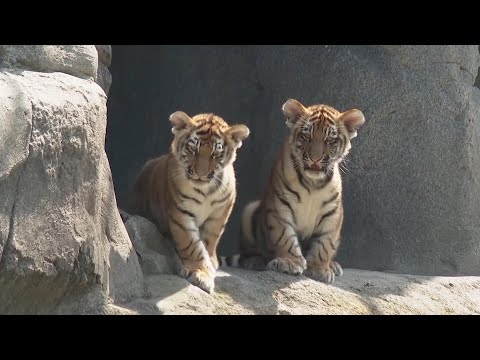(18 Jul 2024)
RESTRICTION SUMMARY:
ASSOCIATED PRESS
Cologne, Germany – 18 July 2024
1. Tiger cubs "Tochka" and "Timur" born mid-April together with their mother "Katinka" in outdoor enclosure of Cologne Zoo
2. Mid of photographers
3. "Tochka" and "Timur" with their mother "Katinka"
4. Mid of photographers
5. "Tochka" and "Timur" with their mother "Katinka"
6. SOUNDBITE (German) Dr. Alexander Silwa, Cologne Zoo curator:
"This is the first birth in eleven years. What is particularly special here is that the cat, i.e. the mother of the two, is 13 years old, which is already relatively old for a tigress. She is particularly genetically valuable, even more genetically valuable than 200 other animals in the European Conservation Breeding Program and we are very, very proud."
7. "Tochka" and "Timur" with their mother "Katinka"
8. Pan left of outdoor enclosure
9. "Sergan", the father of the cubs, roaming separately through enclosure next to them
10. "Tochka" and "Timur" with their mother "Katinka"
11. Mid of photographers
12. Tochka" and "Timur" at the enclosure
13. Wide of the enclosure
14. Tochka" and "Timur" playing
15. Mid of photographers
16. Tochka" and "Timur" playing
STORYLINE:
Cologne Zoo in Germany showed off two Amur tigers born in mid-April to the public on Thursday.
The cubs were allowed to roam the outdoor area of the new tiger enclosure, which opened in 2020, for the first time together with their 13-year-old mother ‘Katinka’ and 9-year-old father ‘Sergan’.
The two kittens are a female and a male. The little cat is called ‘Tochka’, which means ‘dot’ or ‘spot’ in the Amur tigers’ region of origin, the Russian Far East.
The reason for the name was a dot on her left front paw. The little tomcat is called ‘Timur’, which means ‘The Iron One’.
Zoo curator Dr Alexander Sliwa called the birth of the highly endangered species a great success for Cologne Zoo’s big cat breeding program.
The kittens weigh around 13 kilograms (28 pounds) each. They are eating well and are lively and alert.
Tochka and Timur still feed almost exclusively on milk. At the same time, their interest in meat, which the animal keepers regularly offer them, is growing.
They are the first tiger cubs at Cologne Zoo for 11 years.
The Amur tiger, also known as the Siberian tiger, is found in the Amur and Ussuri regions of the Russian Far East, near the Harbor city of Vladivostok.
After a catastrophic decline of this subspecies to only around 50 animals in 1940, the wild population has increased again to around 500, thanks to consistent conservation measures.
The Amur tiger population is also slowly recovering in neighboring north-east China.
However, like all tigers worldwide, they are still threatened with extinction due to habitat destruction, hunting of their natural prey and – above all – poaching for use in traditional Chinese medicine.
AP video shot by Daniel Niemann
===========================================================
Clients are reminded to adhere to all listed restrictions and to check the terms of their licence agreements. For further assistance, please contact the AP Archive on: Tel +44(0)2074827482 Email: info@aparchive.com.
Find out more about AP Archive: http://www.aparchive.com/HowWeWork
Twitter: https://twitter.com/AP_Archive
Facebook: https://www.facebook.com/APArchives
Instagram: https://www.instagram.com/APNews/
You can license this story through AP Archive: http://www.aparchive.com/metadata/youtube/45566676498b4fcc9c5931e644d26689
Author: AP Archive
Go to Source
News post in July 23, 2024, 3:04 pm.
Visit Our Sponsor’s:
News Post In – News





